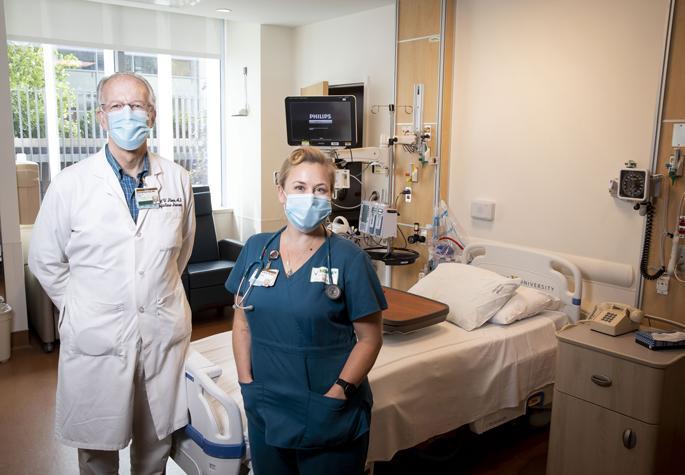Vanderbilt University Medical Center (VUMC) is launching a clinical trial of promising treatments for COVID-19 in the outpatient setting. The trial is part of the national ACTIV-2 protocol to evaluate the safety and efficacy of new potential therapeutics in adult patients who have COVID-19 illness but are not hospitalized.
VUMC is one of 25 sites nationwide that will conduct ACTIV-2, which includes both phase 2 and phase 3 evaluations of multiple potential therapeutics for COVID-19 in a single trial. There are currently no FDA-approved vaccines or therapeutics to prevent or treat COVID-19. For information about enrolling in the trial at Vanderbilt, visit the study website.
“We are doing this study to find a safe and effective treatment for COVID-19 for people in our community, nationwide and around the world. Our hope is that the treatment keeps people alive and out of the hospital,” said David Haas, MD, professor of Medicine and principal investigator for the study at VUMC. “When people are infected with COVID-19, they may feel pretty well at first, but they can become very sick very fast, no matter their age. People newly diagnosed with COVID-19 in the Nashville area, and who are not hospitalized, can make a huge contribution by volunteering for this study.”
ACTIV-2 is a randomized, blinded, controlled adaptive study that will allow many different investigational drugs to be tested over the course of the study. The study is designed to efficiently test multiple new drugs, alone or in combination, compared to placebo within the same clinical trial. Volunteers who enter the study will be compensated for their participation.
The first stage of ACTIV-2 is a phase 2 clinical trial that will evaluate the safety, antiviral activity and ability of investigational drugs to reduce the duration of COVID-19 symptoms. The first investigational drug being evaluated is LY3819253, a monoclonal antibody produced by Eli Lilly and Company in partnership with AbCellera Biologics.
In the first stage, 220 volunteers who have symptoms of COVID-19 and test positive for the SARS-CoV-2 virus, but are not hospitalized, will be randomly assigned to receive the study drug or placebo. If the study drug shows positive results and meets specific criteria for further evaluation, it will advance to the second stage of ACTIV-2, a phase 3 clinical trial, to test whether it can prevent hospitalization and death in non-hospitalized adults with COVID-19. The phase 3 stage will enroll an additional 1,780 volunteers.
ACTIV-2 is sponsored by the National Institute of Allergy and Infectious Diseases (NIAID), part of the National Institutes of Health (NIH). ACTIV-2 is part of NIH’s Accelerating COVID-19 Therapeutic Interventions and Vaccines (ACTIV), a public-private partnership to develop a coordinated research strategy that speeds development of the most promising treatments and vaccines. The study is also receiving support from Operation Warp Speed, the U.S. government’s multi-agency effort to accelerate the development, manufacturing and distribution of COVID-19 vaccines, therapeutics and diagnostics.
ACTIV-2 is being led by the NIAID-funded AIDS Clinical Trials Group, which includes the Vanderbilt Therapeutics Clinical Research Site (VTCRS) directed by Haas. ACTIV-2 does not focus on people living with HIV; it is using the infectious disease and clinical trials expertise of the group.
The VTCRS team will administer treatments that require a hospital setting, such as antibody infusions, in VUMC’s Communicable Disease Response Unit (CDRU), located within the Clinical Research Center. The CDRU was established in 2015 in response to the Ebola epidemic and was designed specifically to care for patients with highly contagious and life-threatening infectious diseases in the safest way possible.
Starting treatment early in infection is a critical component of ACTIV-2, and the timing presents a challenge to sites across the country.
“Very few hospitals and clinics are designed so that people with active, contagious COVID-19 may safely enter the facility just to be in a research study. Generally, people with active COVID-19 only go to the hospital if they are sick enough to possibly require hospitalization. Pretty much the last thing you want to ask someone with active COVID-19 to do is come into the hospital or clinic,” said Beverly Woodward, MSN, RN, a research nurse in the Division of Infectious Diseases and manager of the VTCRS team. “We’re fortunate at VUMC to have the CDRU located within the Clinical Research Center, so it works out pretty perfectly.”
The CDRU includes state-of-the-art ventilation and negative pressure systems, exterior access and an area for clinicians and researchers to put on and remove personal protective equipment, disinfect equipment and perform hand hygiene outside of the patient room in a space that is buffered from the rest of the Medical Center.
Joining Haas and Woodward in the ACTIV-2 study are their team of research specialists, including multiple nurses. One of the VTCRS nurses, Joan Gottesman, BSN, RN, is also contributing at the national level as one of two field representatives for the multisite study.
At least half of the participants who enroll in ACTIV-2 must have factors that increase their risk of developing severe COVID-19, including being at least 55 years old or having a condition such as chronic lung, kidney or liver disease. VUMC is committed to enrolling individuals representing communities most impacted by COVID-19 and the team will work with community partners to make the study accessible to those who are often underrepresented in medical research.
###
For more information about ACTIV-2, go to the national study website the VUMC study website or ClinicalTrials.gov using study identifier NCT04518410.



















































